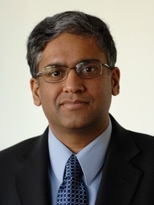Anantha Chandrakasan, director of MIT's Microsystems Technology Laboratories, today received the Semiconductor Industry Association (SIA) University Researcher Award.
Chandrakasan, the Joseph F. and Nancy P. Keithley Professor of Electrical Engineering, was honored for his work in micro-power design, wireless micro-sensor arrays and ultra-wideband radios.
Chandrakasan recently completed a joint project with Texas Instruments to design a micro-controller that uses only one-tenth the power compared to a conventional device. His group has also recently demonstrated ultra-low-power video architectures, energy-efficient ultra-wideband wireless circuits, energy scavenging systems and a sensor system using carbon nanotubes.
Hector Ruiz, chairman of SIA, said that Chandrakasan's work addresses the significant challenges faced by the semiconductor industry today.
"The 'crown jewel' in the U.S. innovation ecosystem is our network of world-leading research universities," Ruiz said in a statement announcing the award to Chandrakasan. "America's research universities attract the best and brightest students and teachers from around the world. University researchers do the fundamental research that has enabled U.S. chipmakers to lead the world in developing innovative products and solutions."
The SIA University Researcher Award was established in 1995 to recognize lifetime research contributions to the U.S. semiconductor industry by university faculty. This year, Kang Wang SM '66 PhD '70 of UCLA was also honored. The awards were presented at the annual SIA conference in Washington.
A version of this article appeared in MIT Tech Talk on March 18, 2009 (download PDF).






